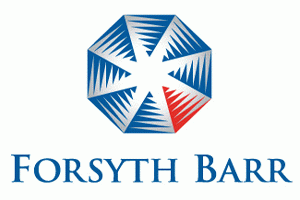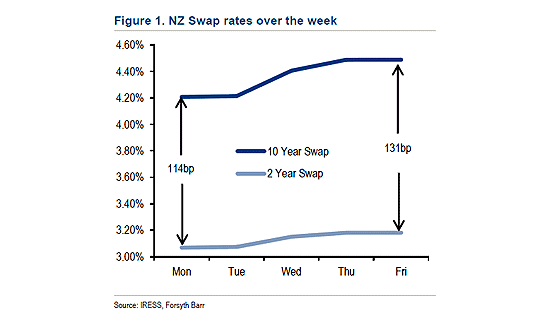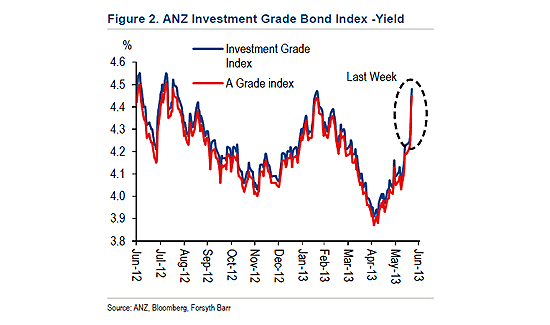
Content supplied by Forsyth Barr
It was certainly a big week.
As global markets digested Bernanke’s tapering schedule, this apparent bitter pill resulted in interest rates and the NZD all recording significant moves last week.
Global markets (both equity and debt markets) are now coming to the realisation that the end of the Fed’s bond buying programme will actually occur - the key question is when?
Central bank rates versus swap rates
For New Zealand bond investors the last two weeks has seen both the Reserve Bank of New Zealand (RBNZ) and the Fed state that their respective benchmark rates (the Official Cash Rate and The Fed Funds Rate) are unlikely to be raised anytime soon.
One must remember that an important distinction must be made when reading commentary around interest rates.
While the OCR may be flat, the key for bond investors is the impact on swap rates. Swap rates are the pricing base for all corporate bond issuance and mortgage rates.
As swap rates rise the value of a bond portfolio decreases. So while the message of ‘interest rates remain unchanged’ is common place, the actual rates which impact bond investors - swap rates - are moving higher, particularly at the longer end of the curve.
Traders in NZD bonds have a different time line to the RBNZ on when the OCR will move.

In our view, bond investors should maintain a bond portfolio duration of around three years in order to reduce the risk to rising interest rates.
RBNZ the winner?
The prospect of higher mortgage rates has also increased over the last week with a couple of major banks having already warned that record low mortgage rates are about to end. As swap rates rise, banks will be forced to raise mortgage rates to cover their cost of funding, this may effectively deliver a tightening for the RBNZ without the Central Bank doing anything.
A dream result for the RBNZ given their view on the New Zealand housing market.
Mixed GDP and current account data
The RBNZ had (less than a week earlier) forecast that the New Zealand economy expanded by +0.5% in the March quarter, however, an actual reading of +0.3% was less than both the RBNZ and the market had been expecting. Given the previous quarter’s +1.5% growth, the reaction from the market to this backward looking figure was minimal.
The current account deficit to GDP improved to -4.8% (from -5.0%) with New Zealand’s net external debt to GDP now at 65.6%. This improvement was not a surprise given that according to Statistics New Zealand, almost a third of New Zealand’s international assets are held in overseas sharemarkets. Strong performance from these markets boosted New Zealand’s asset values by NZ$2.4bn.
Credit markets
Credit markets were wider across the board last week as one would expect given the movement in bond markets. Both Europe and Australian credit were +17bp wider with the US performing a touch better at +14bp.
In New Zealand, the yield on the ANZ Investment Grade Bond Index rose +24bp over the week to start the week at 4.48%, the yield on the index is now +57bp higher than its record low of 3.91% on 8 May 2013.

Any tapering will be data driven
The market had spent considerable time (since May 22 to be precise!) getting itself prepared for the Fed announcement, and when it came the market wasted no time in digesting the comments and unleashing its feelings on the bond and equity markets.
So what did the Fed say? (and why do we care in NZ?)
Firstly, it started back with statements made to Congress by Fed Chairman Ben Bernanke on 22 May regarding a ‘possible’ slowdown of its US$85bn/month bond buying programme, which the market dubbed ‘tapering’.
Since those statements, the market/experts/commentators have all been obsessing over when or if the Fed will ease back on its current stimulus programme.
Lets be clear that the Fed announcement last week made no changes to any of its existing monetary policies, it just outlaid a more positive view on the US economy. The Fed did not announce it will do less but rather how and when it will do less going forward, However, by describing the beginning of the end of its unconventional policies, this was treated no differently than actually implementing this course of action.
At the end of the day, any tapering will be dependant on the economic data that supports the withdraw of stimulus. While interest rates may head higher (which they already have done) there may well be some consolidation until certainty about a US economic recovery is witnessed.
Consequences for NZ
As we have done and continue to do, we highlight the close correlation between New Zealand bonds and US treasuries (at the long end of the curve), the impact of a bond sell-off in the US has consequences for the New Zealand bond market. The reaction in our local market to the Fed’s comments have been swift to say the least:
- On the Thursday immediately after the Fed’s comments, New Zealand swap rates were +14bp to +19bp higher across the 5-year to 10-year part of the curve.
- The steepness (10yr less 2yr) of the New Zealand swap curve is now +45bp steeper than it was on 3 May 2013.
- The April 2023 New Zealand Government Bond was sold off +33bp (or 10%) on Thursday. At the time of going to print the yield on the 2023 NZGB was 4.25%.
- The yield on the ANZ Investment Grade Bond Index rose +24bp over the week. The yield on the index is now +57bp higher than its record low of 3.91% on 8 May 2013.
Corporate / Credit news
The New Zealand Debt Management Office (DMO) announced it intends to offer a new inflation-indexed bond in or around September. The inflation linker will have maturity of 2030 and will be sold through a syndication process. The DMO sold NZ$120m of New Zealand Government Bonds (NZGB’s) at auction last week. The auction of April 2020’s received NZ$352m of bids and were sold at an average yield of 3.7805%, +46bp on its previous auction.
Downer EDI (DOW) had its credit rating upgraded by Fitch Ratings from BBB- to BBB. Its outlook remains Stable. The reasons for the upgrade related to an improved financial risk profile, earnings diversification and more discipline around the vetting of project bids.
Fonterra (FCG) had its A+ credit rating affirmed by S&P. Its outlook was also affirmed as Stable.
Heartland Bank (HNZ) confirmed it will repay its outstanding bonds (MAR010) when they mature on 15 July 2013. The record date is 5 July 2013.
The Local Government Funding Agency (LGFA) held tender number 13, offering NZ$15m of December 2017’s which received NZ$30m of bids from 8 bidders and were sold at an average yield of 3.9283%. The NZ$270m of May 2021 LGFA bonds received NZ$547m worth of bids from 56 different bidders (successful bidding range 26bp!). The bonds were sold at an average yield of 4.4648%.
NZ Post (NZP) announced it plans to cut up to 100 jobs. The job cuts will be in management with the restructure only affecting 6% of its 1300 corporate staff.
----------------------------------------------------
Disclosures and Disclaimers:
Disclosure: The comments in this publication are for general information purposes only. This publication is not intended to constitute investment advice under the Securities Markets Act 1988. If you wish to receive specific investment advice, please contact your Investment Advisor. Forsyth Barr Limited and its related companies (and their respective officers, agents and employees) may own or have an interest in securities or other products referred to in this publication, and may be directors or officers of, or provide investment banking services to, the issuer of those securities or products, and may receive fees for acting in any such capacity in relation to that issuer. Further, they may buy or sell securities as principal or agent, and as such may undertake transactions that are not consistent with any recommendations contained in this publication. Forsyth Barr Limited and its related companies (and their respective officers, agents and employees) confirms no inducement has been accepted from the researched/recommended entity, whether pecuniary or otherwise, in connection with making any recommendation contained in this publication or on our website.
Analyst Disclosure Statement: In preparing this publication the analyst(s) may or may not have a threshold interest in the securities mentioned in this publication. A threshold interest is defined as being a holder of more than $50,000 or 1% of the securities on issue, whichever is the lesser. In preparing this publication non-financial assistance may have been provided by the entity being researched. A disclosure statement is available on request and is free of charge.
Disclaimer: This publication has been prepared in good faith based on information obtained from sources believed to be reliable and accurate. However, that information has not been independently verified or investigated by Forsyth Barr Limited. Accordingly, Forsyth Barr Limited: (a) does not make any representation or warranty (express or implied) that the information is accurate, complete or current; and (b) excludes and disclaims (to the maximum extent permitted by law) any liability for any loss which may be incurred by any person as a result of that information being inaccurate or incomplete in any way or for any reason. The information, analyses and recommendations contained in this publication are confidential to the intended recipients and are statements of opinion only. They have been prepared for general information purposes and whilst every care has been taken in their preparation, no warranty or representation is given (express or implied) as to their accuracy or completeness. Nothing in this publication should be construed as a solicitation to buy or sell any security or other product, or to engage in or refrain from doing so or engaging in any other transaction. This publication should not be used as a substitute for specific advice. This publication is intended to provide general securities advice only, and has been prepared without taking account of your objectives, financial situation or needs, and therefore prior to acting on any information, analysis or recommendation contained in this publication, you should seek advice from your usual Investment Advisor. Forsyth Barr Limited and its related companies (and their respective officers, agents and employees) will not be liable for any loss whatsoever suffered by any person relying upon any such information, analysis or recommendation. This publication is not intended to be distributed or made available to any person in any jurisdiction where doing so would constitute a breach of any applicable laws or regulations.
We welcome your comments below. If you are not already registered, please register to comment
Remember we welcome robust, respectful and insightful debate. We don't welcome abusive or defamatory comments and will de-register those repeatedly making such comments. Our current comment policy is here.